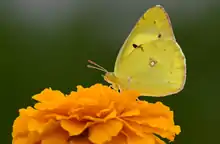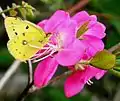Colias erate
Colias erate, commonly known as the eastern pale clouded yellow, is a species of butterfly in the family Pieridae. It is found from south-eastern Europe, through Turkey over central Asia up to Japan and Taiwan. To the south, its range stretches to Somalia and Ethiopia. The species was first described by Eugenius Johann Christoph Esper in 1805.[1] [2]
| Eastern pale clouded yellow | |
|---|---|
 | |
| C. e. poliographus | |
| Scientific classification | |
| Domain: | Eukaryota |
| Kingdom: | Animalia |
| Phylum: | Arthropoda |
| Class: | Insecta |
| Order: | Lepidoptera |
| Family: | Pieridae |
| Genus: | Colias |
| Species: | C. erate |
| Binomial name | |
| Colias erate (Esper, 1805) | |
| Synonyms | |
| |
The butterfly flies in May to September in two generations.
The larvae feed on various Fabaceae species, such as Medicago sativa and Medicago, Trifolium, Onobrychis and Melilotus species.
Subspecies
- C. e. erate (Ukraine, Turkey, Lebanon, Bulgaria, Romania, Macedonia, Greece, Hungary, Austria, Turkmenistan, Kazakhstan, Kirhizia, Uzbekistan, Tajikistan, Afghanistan)
- C. e. amdensis Verity, 1911 (China: Qinghai, Gansu, Sichuan)
- C. e. marnoana Rogenhofer, 1884 (Sudan, Ethiopia, south-western Arabia)
- C. e. sinensis Verity, 1911 (Mandschuria, North Korea)
- C. e. formosana Shirôzu, 1955 (Taiwan)
- C. e. lativitta Moore, 1882 (Nepal, northern India)
- C. e. poliographus Motschulsky, 1860 (Mongolia, Japan, Amur, Ussuri, Sakhalin, Tian Shan)
- C. e. tomarias Bryk, 1942 (Kuriles)
- C. e. naukratis Fruhstorfer, 1909 (Altai, southern Siberia, Transbaikalia)
- C. e. nilagiriensis C. & R. Felder, 1859 (southern India)
Description
The wingspan is 23–26 mm. the Central Asian butterflies are generally larger than European ones. C. erate has slightly more pointed wingtips than related species. Like most Colias species, Colias erate has yellow ground colouration. Females with whitish tinged wings are sometimes found in Europe and predominate in Central Asia. The butterflies are extremely variable in their colouring and therefore very difficult to distinguish from similar species of the same genus. The wing tops are lemon yellow in color and have a broad black colored outer edge. Around the wing tip, the black also runs towards the leading edge. In the males the black is strong and only with little or no yellow submarginal spots interspersed, in the females it is pale and moreover includes several such spots. Approximately in the middle of the forewing, slightly offset from the front edge, there is a small black spot. The upper sides of the hind wings are also colored lemon yellow, but lightly dusted with dark. A large part of the outer edge is also darkly edged,but not as broadly. In the females, the black is again significantly paler and in places interrupted by yellow. There is an orange spot in the middle of the wing. The undersides of both pairs of wings are more strongly coloured yellow and slightly dusted with dark olive green. The entire edge is finely reddish edged. The black spot on the forewings is also found on the underside along with a few other submarginal spots along the outer edge. Instead of the orange spot, there is a lighter, reddish-edged spot on the hind wings, bordered by another very small spot. The dark row of submarginal spots on the forewings continues on the outer edge of the hindwings, but is only faintly discernible. [3]
Frederic Moore (1882) gives a detailed description for C. e. lativitta:
Male. Yellow: fore wing with a broad unspotted blackish band,the inner border of which is angulated inward at the upper median vein; the band very sparsely yellow-speckled on the anterior veins; discocellular spot large, black: hind wing with a broad blackish crenulated band and a large orange-yellow discocellular spot. Underside olivaceous yellow: fore wing with a black discocellular spot and a distinct discal row of spots: hind wing with a moderate-sized dull pearly-white red-bordered discocellular spot.
Female. Yellow, or white; the band on fore wing broader than in male, and with not very prominent upper and lower yellow spots; the discocellular spot distinct: hind wing darker, with broad marginal band traversed inwardly by large ill-defined yellow spots; discocellular spot brighter red.
Expanse 1 5/8 to 2 2/8 inches.
Gallery
 C. e. erate ventral view (male)
C. e. erate ventral view (male) C. e. erate dorsal view (male)
C. e. erate dorsal view (male) C. e. erate ventral view (female)
C. e. erate ventral view (female) From Japan
From Japan Feeding on nectar of Rhododendron albrechtii
Feeding on nectar of Rhododendron albrechtii
Cited references
- Savela, Markku. "Colias erate (Esper, 1805)". Lepidoptera and Some Other Life Forms. Retrieved July 1, 2018.
- Varshney, R.K.; Smetacek, Peter (2015). A Synoptic Catalogue of the Butterflies of India. New Delhi: Butterfly Research Centre, Bhimtal & Indinov Publishing, New Delhi. p. 23. doi:10.13140/RG.2.1.3966.2164. ISBN 978-81-929826-4-9.
- Lionel G. Higgins, Norman D. Rilley: The Butterflies of Europe and Northwest Africa (A Field Guide to the Butterflies of Britain and Europe). Paul Parey Publishers, 1971, ISBN 3-490-02418-4 .
-
 One or more of the preceding sentences incorporates text from this source, which is in the public domain: Moore, Frederic (1882). Proceedings of the Zoological Society of London. p. 255.
One or more of the preceding sentences incorporates text from this source, which is in the public domain: Moore, Frederic (1882). Proceedings of the Zoological Society of London. p. 255.
External links
- Russian Insects poliographus Motschulsky, 1860
- www.lepiforum.de - taxonomy and photos
- www.schmetterling-raupe.de
- Moths and Butterflies of Europe and North Africa
- Fauna Europaea